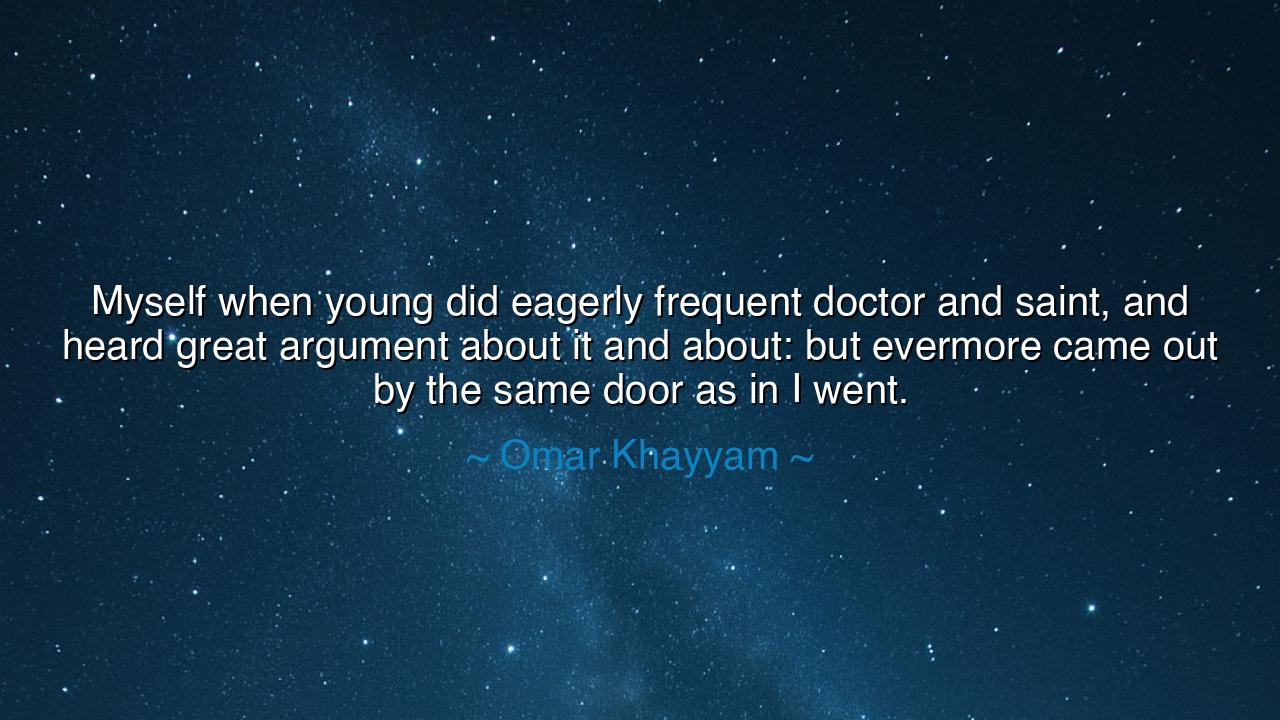
Myself when young did eagerly frequent doctor and saint, and
Myself when young did eagerly frequent doctor and saint, and heard great argument about it and about: but evermore came out by the same door as in I went.






The words of Omar Khayyam — “Myself when young did eagerly frequent doctor and saint, and heard great argument about it and about: but evermore came out by the same door as in I went” — speak from the deep well of human experience. They carry the weary tone of one who has sought truth through every path of intellect and faith, only to find that wisdom is not always found in temples or in theories, but in the still silence of the soul. This verse, drawn from The Rubáiyát, is both a confession and a revelation: the journey for ultimate understanding often returns us to where we began, yet leaves us inwardly transformed.
When Khayyam speaks of visiting doctor and saint, he speaks of the two ancient roads mankind has always traveled — the road of reason and the road of faith. The doctor represents knowledge, science, and logic; the saint represents belief, mysticism, and devotion. The poet, young and eager, sought answers from both. He listened to their “great arguments about it and about” — about life, the soul, destiny, and the divine — but found that neither path could fully satisfy the hunger within. The more he listened, the more he realized that the words of men, no matter how wise, could not still the eternal question echoing in the heart.
This theme is as old as philosophy itself. Socrates, the wisest man of Athens, declared, “I know that I know nothing.” Though surrounded by scholars, he discovered that knowledge is a circle: the larger it grows, the more it reveals the darkness beyond its edge. Likewise, Buddha, before enlightenment, sought out teachers of every kind — ascetics, mystics, scholars — but in the end, he sat beneath the Bodhi tree alone. Both Khayyam and Buddha remind us that truth is not found in borrowed wisdom, but in the quiet awakening that follows the exhaustion of seeking.
In Khayyam’s age — the golden era of Persian science and philosophy — men were obsessed with reconciling reason and religion. They debated the cosmos, the will of God, the nature of eternity. Yet amid all this brilliance, Khayyam found a profound irony: that the greatest minds often walk in circles, leaving by “the same door as in they went.” It is a metaphor for the limitations of human understanding. We may accumulate facts and prayers alike, but the mystery of existence remains — vast, unsolved, humbling.
And yet, within this disillusionment, there is not despair, but wisdom. For Khayyam’s realization is not that truth does not exist, but that it cannot be owned. The search itself refines the soul; the failure to find becomes its own form of grace. To return by the same door is not to end where we began, but to see the beginning anew, with eyes tempered by humility. The true sage learns that to question is holy, and that mystery is not the enemy of meaning — it is its heart.
We may see a reflection of this in the life of Leonardo da Vinci, who studied anatomy, astronomy, art, and philosophy — yet on his deathbed, said he had offended God and mankind by not doing enough. Even the greatest minds, like Khayyam, sense that knowledge is a candle before the infinite. Their humility becomes their sanctity. They realize that wisdom is not the possession of truth, but the reverence for it.
So let this be the lesson for those who walk the path of inquiry and belief alike: seek teachers, but do not worship them. Listen to saints, but question even them. Pursue understanding, but know that its horizon will always recede. For the journey itself — the wonder, the struggle, the humility — is what makes a soul wise. As Khayyam teaches through his wearied yet luminous verse, the greatest truth may not be found in answers, but in the courage to keep asking.






AAdministratorAdministrator
Welcome, honored guests. Please leave a comment, we will respond soon